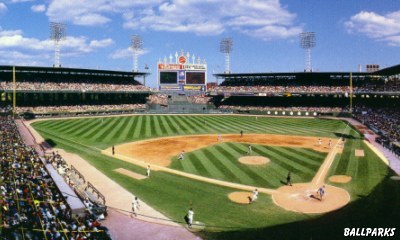Comiskey Park
Chicago, IllinoisTenant: Chicago White Sox Architect: Zachary Taylor Davis; Osborn Engineering (1910) Chicago White Sox tickets:
Location: Left field (N), West 34th; third base (W), Portland Avenue, later called South Shield’s Avenue; first base (S), 324 West 35th Street; right field (E), South Wentworth Avenue, later Dan Ryan Expressway/I-94. Dimensions: Foul lines: 363 (1910), 362 (1911), 365 (1927), 362 (1930), 342 (1934), 353 (1935), 340 (1936), 352 (1937), 332 (April 22, 1949), 352 (May 5, 1949), 335 (1969), 352 (marked, 1971), 349 (actual, 1971), 341 (1983), 347 (1986); power alleys: 382 (1910), 375 (1927), 370 (1934), 382 (1942), 362 (April 22, 1949), 375 (May 5, 1949), 382 (1954), 365 (1955), 375 (1956), 365 (1959), 375 (1968), 370 (1969), 375 (marked, 1971), 382 (actual, 1971), 374 (1983), 382 (1986); center field: 420 (1910), 450 (1926), 455 (1927), 450 (1930), 436 (1934), 422 (1936), 440 (1937), 420 (April 22, 1949), 415 (May 5, 1949), 410 (1951), 415 (1952), 400 (1969), 440 (1976), 445 (1977), 402 (marked, 1981), 409 (actual, 1981), 401 (1983), 409 (1986); backstop: 98 (1910), 71 (1933), 85 (1934), 86 (1955); foul territory: large. Fences: Foul lines and power alleys: 12 (concrete, 1955), 9.83 (concrete, 1959), 5 (wire, 1969), 9.83 (concrete, 1971); center field: 15 (1927), 30 (1948), 17 (1976), 18 (1980); left-center to right-center inner fences: 5 (canvas, 1949), 6.5 (24-foot section in front of bullpens, 1969), 9 (1974), 7 (canvas, 1981), 7.5 (1982), 11 (1984), 7.5 (1986).
White Sox owner Charles A. Comiskey wanted a modern concrete-and-steel stadium to replace South Side Park which had become obsolete. Ground was broken on February 10, 1910 and the White Sox played their first game there on July 1 that year, losing to the St. Louis Browns (now the Baltimore Orioles), 2-0. In it's original configuration, the park consisted of a covered double-decked grandstand that curved around home plate and extended along the foul lines about thirty feet. Two roofed single-decked pavilions continued down the foul lines, detached from the grandstand. Wooden bleachers surrounded the outfield, except for center field, where the scoreboard was. In the winter of 1926-27, the wooden bleachers were replaced with concrete and steel and double-decked, and the pavilions from left around home plate to right were double-decked. The scoreboard was moved from center-field to two locations on the left field and right field walls and uncovered single-deck bleachers were added in center field. In 1947 the center-field bleachers were eliminated to improve batters’ visibility and in 1950, the bullpens were moved from foul territory down the lines to behind the center-field fence. Bill Veeck installed the first exploding scoreboard in the majors, high above the bleachers in center for the 1960 season. In 1982, when the DiamondVision board replaced the original, the pinwheels were retained. During Comiskey's eighty years of existence, 72,801,381 fans paid to see games there. Before old Comiskey Park was demolished in 1991, the infield dirt was moved to new Comiskey Park. Comiskey park was the scene of many masterful groundskeeping tricks by Roger, Gene, and Emil Bossard: "Camp Swampy" in 1967 referred to the area in front of home plate that was dug up and soaked with water when White Sox sinkerball pitchers were on the mound; however, the dirt was mixed with clay and gasoline and burned to provide hard soil if a sinkerballer was pitching for the visiting team. Opposing team bullpen mounds were lowered or raised from the standard 10-inch height to upset visiting pitchers’ rhythm. Under Eddie Stanky’s managerial tenure, the grass in front of shortstop was cut long because the Sox shortstop had limited range, but at second base the grass was cut short because the Sox second sacker had very good range. When the Sox had a lousy defensive outfield, the grass was cut long to turn triples into doubles. When the Sox had speedy line drive hitters, the outfield grass was cut short to turn singles into doubles. When the Sox had good bunters, more paint was added to the foul line in order to tilt the ball back fair.
Trivia:
Recommended Reading (bibliography):
Help us provide a better web site by completing our feedback form IMAGES: View inside Comiskey Park by Munsey & Suppes. Updated November 2002 Tickets to Chicago Cubs, Chicago White Sox, NCAA Basketball Tournament, College Football Bowl, NCAA Football and Paul McCartney provided by Ticket Triangle. BALLPARKS © 1996-2014 by Munsey & Suppes.
|






